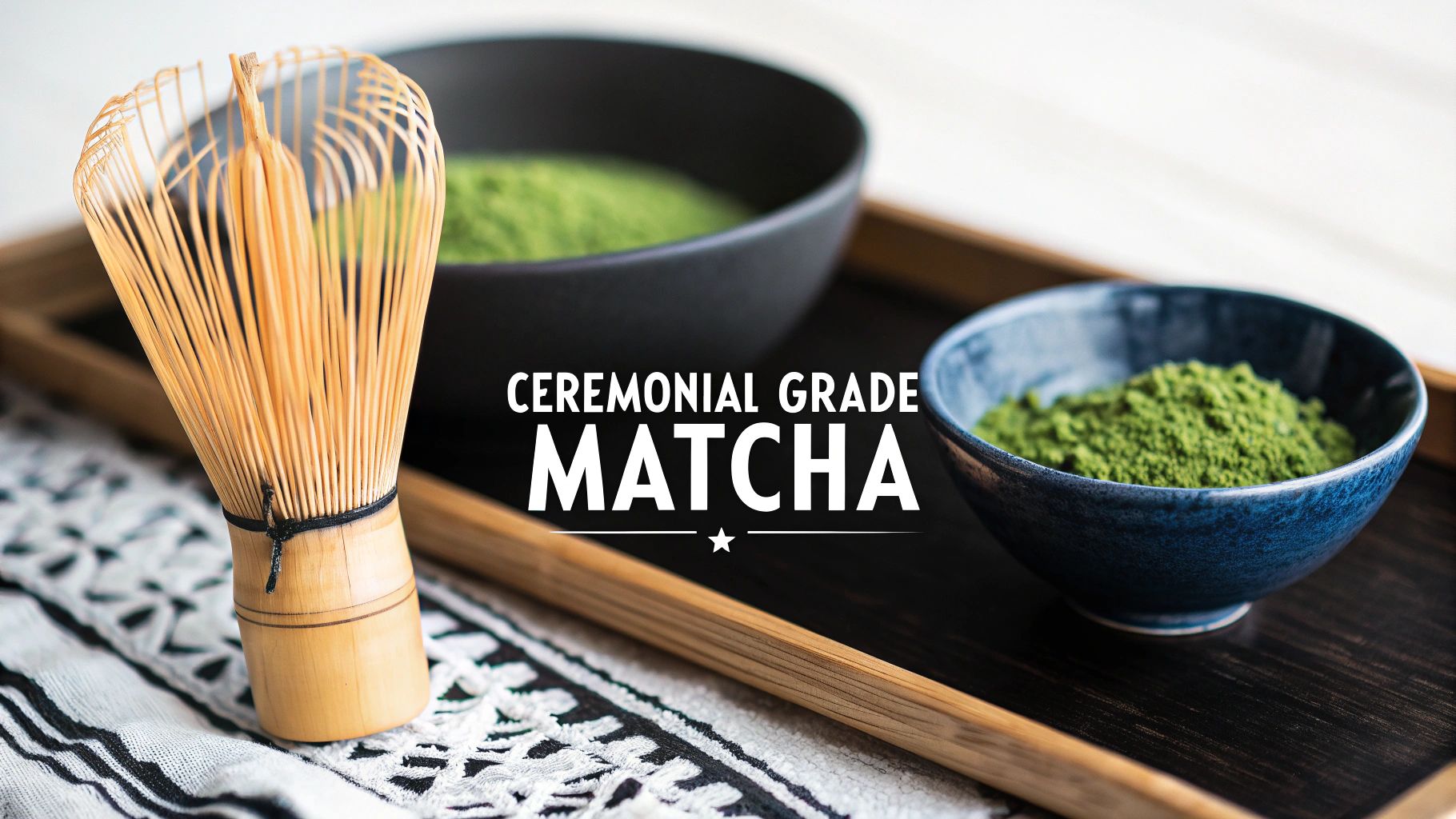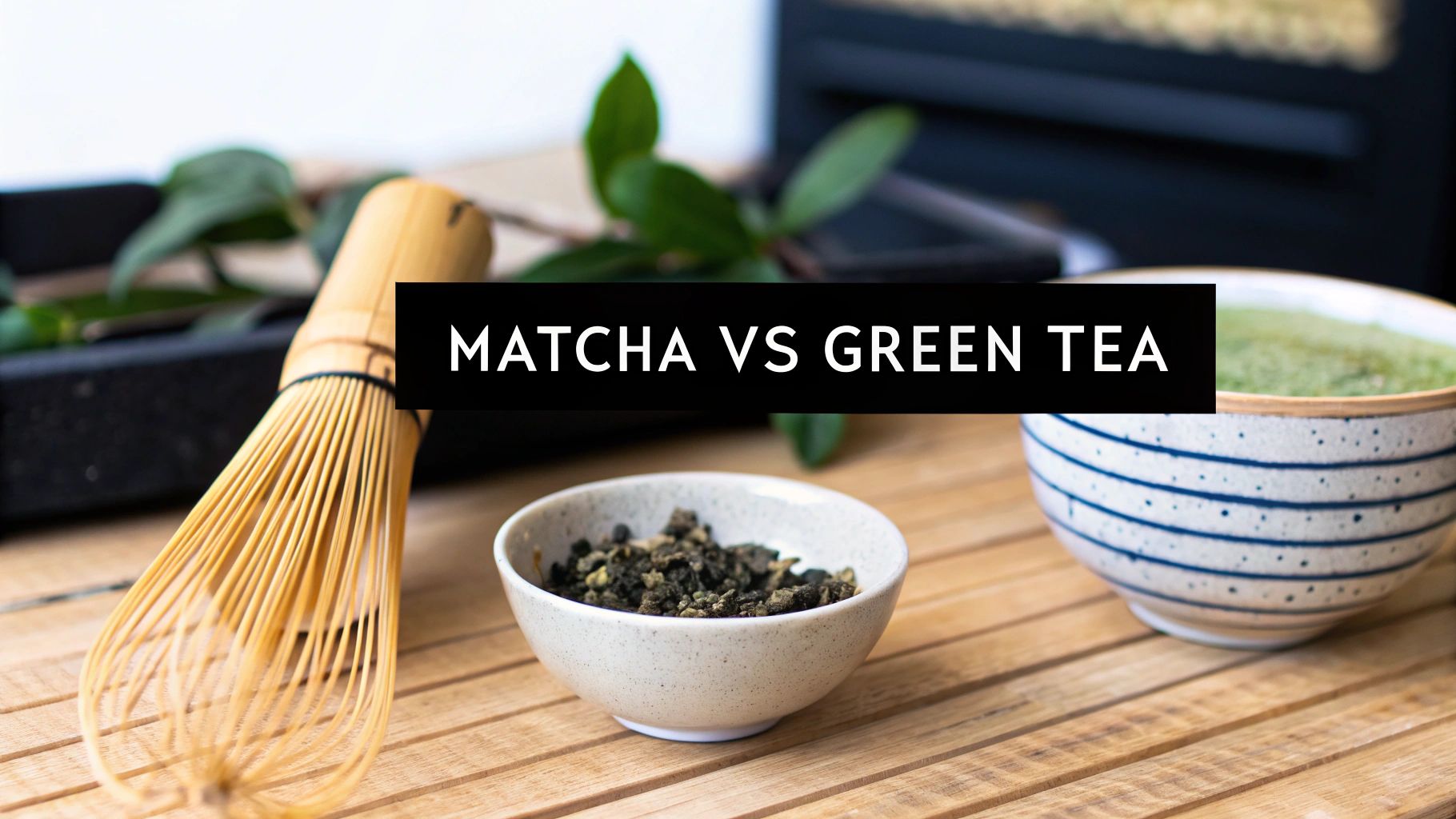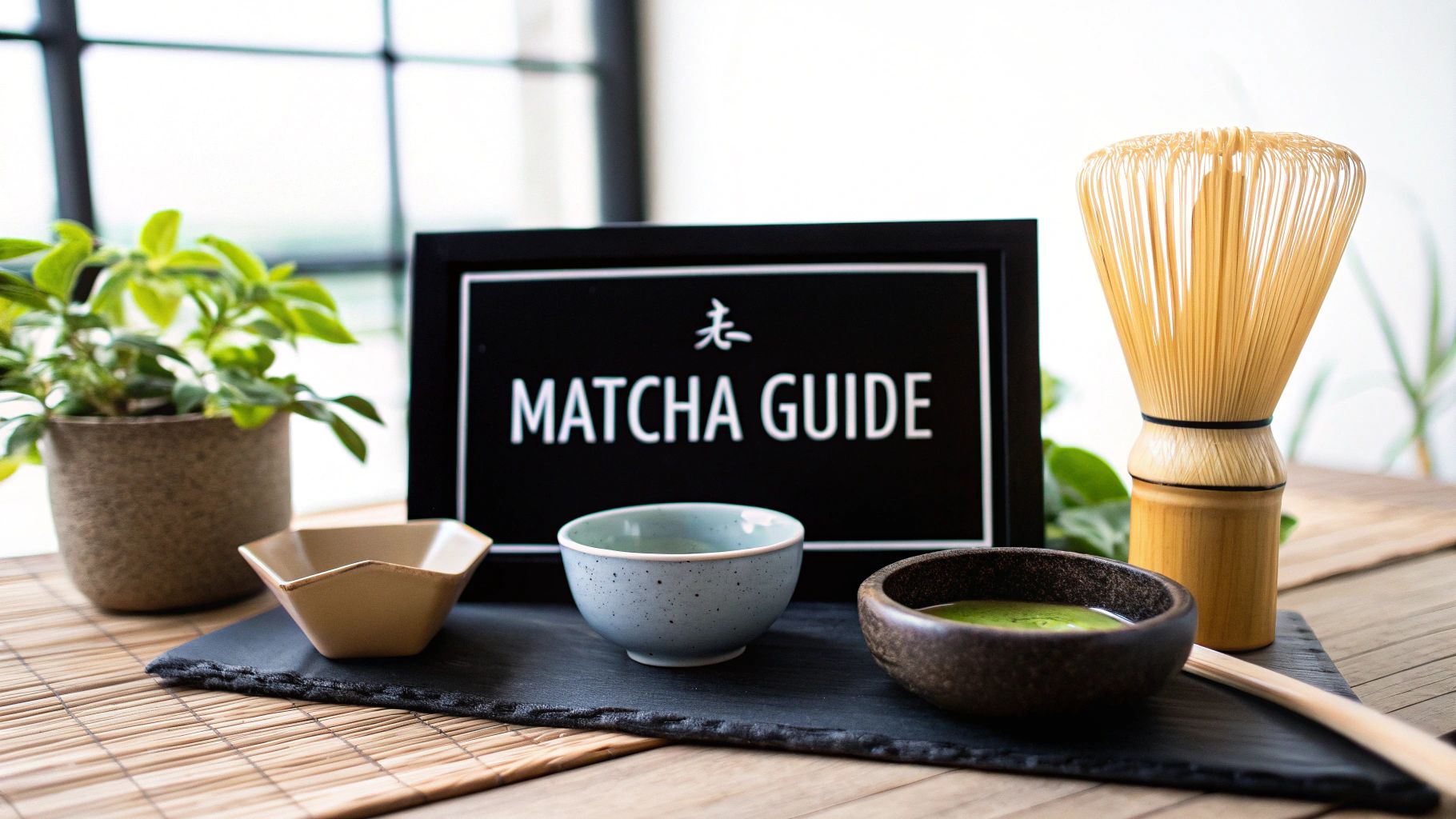A matcha tea ceremony set is far more than just a few tools bundled together. Think of it as your personal gateway to the full experience of Japanese matcha, turning the simple act of making tea into a genuinely calming and mindful ritual.
Your Invitation to a Mindful Ritual
So, you’ve discovered the vibrant green powder and you're curious. A proper matcha tea ceremony set is your next logical step, an invitation to connect with this ancient tradition on a much deeper level. It’s about moving beyond just stirring powder into water and embracing a deliberate process that honours the tea and settles the mind.
At its heart, a traditional set is all about creating that perfect bowl of matcha, where every piece plays its part. This isn't about making things complicated; it’s about being precise and intentional. The right tools ensure the delicate tea powder is perfectly whisked and aerated, giving you that smooth, frothy texture and unlocking all those complex, nuanced flavours. Without them, you often end up with a lumpy, bitter drink that completely misses the point of what makes matcha so special. You can explore more about what is in matcha powder in our detailed guide.
Making Tradition Approachable
The rise of matcha in the UK has been impossible to miss. In 2023 alone, sales of matcha drinks shot up by a staggering 202 percent, fuelled by people’s growing interest in both its health benefits and its undeniable aesthetic appeal. It really points to a bigger shift towards more mindful habits. Read more about the rise of matcha in the UK.
This guide is here to pull back the curtain on the Japanese tea ceremony, showing you how it can be an accessible and relaxing tradition you can easily bring into your own home.
A quality set is an act of respect for the tea itself. It ensures that every sip of a premium, ceremonial-grade blend like Amatsu Matcha's Pure is experienced exactly as the artisans who crafted it intended—rich, creamy, and full of life.
Ultimately, getting a proper set isn't just about making better tea. It’s about carving out a little space in your day for a ritual that brings focus, calm, and a stronger connection to the here and now.
Unpacking Your Matcha Toolkit
A traditional matcha tea ceremony set is more than just a collection of tools; it’s a beautifully designed system where every piece has a purpose. Think of it like a chef's knife set – each blade is crafted for a specific task, and using the right one makes all the difference. These items aren't merely decorative; their time-honoured designs are key to unlocking matcha's true flavour, texture, and aroma.
Getting to know each component turns making matcha from a simple task into a mindful, enjoyable ritual. Let's take a closer look at what's inside and the role each tool plays.

This image gives you a great overview of the essential pieces. While each is unique, they all work together in harmony to help you craft the perfect bowl.
Your Matcha Set Components at a Glance
To give you a clearer picture, this table breaks down the core instruments of the matcha ceremony, their Japanese names, and what they do.
| Component | Japanese Term | Primary Role in Brewing |
|---|---|---|
| Tea Bowl | Chawan (茶碗) | The vessel for whisking and drinking; designed for aeration. |
| Bamboo Whisk | Chasen (茶筅) | Creates the signature creamy froth and silky texture. |
| Bamboo Scoop | Chashaku (茶杓) | Measures the perfect portion of matcha powder. |
| Tea Caddy | Natsume (棗) | An airtight container to keep matcha powder fresh. |
Each of these tools has evolved over centuries to perfect the art of matcha preparation, making them indispensable for an authentic experience.
The Chawan (Tea Bowl)
First up is the Chawan (茶碗), or tea bowl. This is the heart of your preparation, the stage where the magic happens. Its wide, flat bottom and tall sides are no accident – they provide the perfect space to whisk vigorously without splashing, allowing air to be incorporated into the tea.
The material, usually ceramic, also plays a crucial part. It holds heat wonderfully, keeping the water at just the right temperature as you whisk. This is vital for properly dissolving the powder and coaxing out that complex, savoury umami flavour that makes a premium matcha like Amatsu's Radiance so exceptional.
The Chasen (Bamboo Whisk)
The Chasen (茶筅) is the delicate-looking but mighty bamboo whisk. Honestly, this is the one tool you simply can't substitute. A standard kitchen whisk just won’t cut it; it can't create the fine, velvety foam that defines a good bowl of matcha.
Carved by hand from a single piece of bamboo, a Chasen typically has between 80 and 120 fine prongs. These tines are designed to suspend the powder particles evenly in the water, whipping up a rich layer of froth and eliminating any chance of clumps. If you want to keep yours in top shape, our guide to the matcha whisk and how to care for it has some great tips.
The Chashaku (Bamboo Scoop)
Next, we have the Chashaku (茶杓). This is the slender, elegant bamboo scoop used for measuring your matcha powder. Its simple, curved design allows you to lift the vibrant green powder gracefully from its container into the Chawan.
In a traditional setting, one heaping scoop from the Chashaku is the standard measure for a single serving of Usucha (thin tea), helping you achieve consistency every time you brew.
The Natsume (Tea Caddy)
Finally, there’s the Natsume (棗), the traditional tea caddy. Matcha is incredibly delicate and loses its vibrancy quickly when exposed to light, air, or moisture. A proper Natsume has an airtight design that shields the powder from these elements, keeping its bright colour and deep flavour locked in, ensuring every bowl of your Amatsu Matcha tastes as fresh as the first.
How to Choose the Right Matcha Set for You
Picking out the perfect matcha tea ceremony set isn't about splashing out on the most expensive one you can find. It’s about finding the right tools for your own personal routine. Think of it like buying a coffee maker – a simple cafetière is spot on for one person, while someone else might want a full-on espresso machine. The best set is simply the one you'll look forward to using every single day.
Your perfect setup really depends on what you're after. Are you just dipping your toes in, curious to get the hang of the basics? Or perhaps you're already a daily matcha drinker, looking to turn a quick stir into a more mindful, calming ritual.
For the Curious Beginner
If you're brand new to the world of matcha, the best place to start is with a simple, well-made starter set. You'll want one that includes the three absolute essentials: a proper Chawan (bowl), a bamboo Chasen (whisk), and a Chashaku (scoop). This core trio is all you need to master the whisking technique and whip up a lovely, frothy bowl of matcha without getting bogged down by extra bits and pieces.
For the Daily Enthusiast
For those of you who've already made matcha a firm part of your daily rhythm, upgrading to a more complete set can really deepen the experience. Look for a set that includes a whisk holder (Kusenaoshi). This little tool is a game-changer; it helps your Chasen keep its delicate shape, which means it will last longer and give you that perfect froth time and time again. You might also enjoy a set with a Natsume (tea caddy) to keep your favourite Amatsu Matcha—whether it's the pure ceremonial Pure, the beauty-enhancing Radiance, or the nootropic Shrooms—perfectly fresh.
Choosing a set is a personal decision that shapes your daily ritual. The goal is to find tools that feel good in your hands and make the process a pleasure, transforming a simple drink into a moment of mindfulness.
The rising popularity of matcha here in the UK really speaks to this desire for more mindful moments. In fact, the UK matcha tea market brought in around USD 61.8 million in revenue in 2024, a figure driven largely by the demand for high-quality powdered products. This growth points to a clear shift towards appreciating not just the tea, but the ritual that comes with it. You can discover more insights about the UK matcha market on Grand View Research.
Mastering Your First Bowl of Matcha
So, you’ve got your beautiful matcha tea ceremony set unpacked and sitting in front of you. This is where the fun really begins. It's the moment you transform that vibrant green powder and a few simple tools into a ritual of pure calm. Don't worry if it seems intimidating; making matcha is a gentle, meditative process that anyone can enjoy.
The journey to the perfect bowl isn't about rushing. It's a series of small, mindful actions. Every step, from warming the bowl to the final rhythmic whisking, flows into the next. Think of it as a practice in mindfulness just as much as a recipe for tea.

Following this ritual is the best way to unlock the complex, nuanced flavours of a ceremonial blend like Amatsu's Pure. It’s also a brilliant way to elevate a daily wellness habit, like preparing our functional Strength blend for a pre-workout boost or Shrooms for extra focus.
Your Step-by-Step Guide to Whisking
Let’s walk through the preparation together. The secret is to move slowly and with intention, letting the process settle into a relaxing rhythm.
-
Warm Your Tools: Start by pouring hot water into your Chawan (bowl). Place your Chasen (whisk) inside to let the bamboo prongs soften for a minute. Then, pour the water out and dry the bowl thoroughly. This little step warms the ceramic, helping your matcha stay at the ideal temperature.
-
Sift Your Matcha: Using your Chashaku (scoop), measure 1-2 scoops of your chosen Amatsu Matcha powder—that’s about 1-2 teaspoons—into the Chawan. Now, gently push the powder through a small sifter. This is the key to getting rid of any little clumps and achieving that perfectly smooth, silky texture.
-
Add Hot Water: Carefully pour around 60-70ml of hot water over the matcha. The ideal temperature is about 80°C. It’s important that the water isn't boiling, as water that's too hot can scorch the delicate tea, leaving you with a bitter taste.
-
Whisk with Purpose: This is the most crucial part. Hold the Chawan firmly with one hand. With the other, whisk the matcha and water back and forth in a brisk ‘M’ or ‘W’ shape. Keep your wrist loose and focus on creating a lovely layer of fine, creamy foam on top.
This rhythmic whisking isn't just for show. It aerates the tea, which releases its delicate aroma and creates that signature velvety mouthfeel of high-quality matcha. It’s a technique that quickly becomes second nature with a little practice.
For an even more detailed walkthrough and a few extra tips, have a look at our complete guide on how to prepare matcha for a flawless finish every time. This simple, mindful process turns every bowl into a truly purposeful experience.
Caring for Your Matcha Ceremony Tools
Your matcha tea ceremony set is more than just a collection of tools; it’s an investment in a daily ritual. With a little care, these beautiful pieces can serve you well for years to come. Think of it not as a chore, but as a simple extension of the mindful process you’ve just enjoyed.
These easy habits reinforce the sense of respect that’s so central to the ceremony, and they ensure your tools are always ready for that next perfect bowl of matcha. Your bamboo tools, in particular, are the most delicate parts of your set, so they appreciate a gentle touch.

Simple Steps for Lasting Quality
Just a few moments of care after each use will make all the difference. It’s like tidying up a peaceful sanctuary after a moment of calm.
-
The Chawan (Bowl): A simple rinse with warm water is all your bowl needs. Afterwards, wipe it dry with a soft cloth. It’s best to avoid harsh soaps, as they can wear away the delicate glaze over time and even interfere with the pure flavour of your matcha.
-
The Chashaku (Scoop): This delicate bamboo scoop should never see a drop of water. Just give it a gentle wipe with a dry, soft cloth to brush off any lingering matcha powder.
-
The Chasen (Whisk): After you’ve frothed your tea, rinse the Chasen under a gentle stream of warm water—no soap needed here, either. The most important step is to let it air dry properly on a Kusenaoshi (whisk holder). This nifty stand helps the delicate tines keep their elegant curve and prevents any chance of mould.
Proper care isn't an afterthought; it’s a fundamental part of the tea ceremony itself. Each gesture of cleaning and storing your tools is an act of appreciation, ensuring they remain in perfect condition for your next mindful moment.
By following these simple practices, you're honouring your tools and the tradition they represent. If you want to dive deeper into the significance behind the ritual, our guide to the Japanese tea ceremony and matcha is a great place to start.
Answering Your Matcha Set Questions
It's completely normal to have a few questions when you're just starting out with a new matcha tea ceremony set. In fact, it’s a great sign that you're diving in and getting curious about the process.
Let's walk through some of the most common queries I hear. Think of this as a quick chat to clear up any uncertainties, so you can feel confident and really start to enjoy your new matcha ritual.
Your Practical Matcha Queries Answered
Here are the straightforward answers to the questions many people have when they first start making matcha at home.
Can I use a milk frother instead of a bamboo whisk?
You can, but it's a bit like using a butter knife to chop vegetables – it'll get the job done, but not very well. A milk frother will certainly mix the powder, but it tends to create large, airy bubbles. A traditional Chasen, on the other hand, with its 80-120 fine bamboo prongs, is designed to do something much more subtle. It whisks the tea particles into a perfect suspension, creating that signature creamy, velvety foam that is the hallmark of beautifully prepared matcha.
What is the difference between ceremonial and culinary grade matcha?
Think of it like the difference between a fine sipping wine and a cooking wine. Ceremonial grade matcha, like our Amatsu Pure and Radiance blends, is made from the youngest, most delicate tea leaves from the very first harvest. This gives it a naturally sweet, smooth flavour profile that's best enjoyed simply with hot water. Culinary grade is made from older leaves, resulting in a bolder, slightly more bitter taste that’s designed to hold its own in lattes, smoothies, and baking. For functional benefits, blends like our Shrooms and Strength use high-quality matcha as a powerful base.
The grade you choose really shapes the experience. For that pure, meditative moment of a traditional tea ceremony, you absolutely want ceremonial grade. For just adding a healthy kick to other recipes, culinary grade is the way to go.
Does the type of bowl really matter?
In a pinch, any bowl will work, but a proper Chawan genuinely makes the experience better. It’s designed specifically for whisking. The wide, flat bottom gives you the space you need to move the whisk properly and build up a beautiful froth without splashing everywhere. More than that, the shape is intended to be held comfortably in both hands, helping you connect with the warmth and aroma of the tea. It turns making a drink into a truly mindful moment.
You can dive deeper into how this mindful practice can positively affect your well-being by reading about the many matcha health benefits in our dedicated article.
Ready to begin your own mindful ritual? Discover the perfect blend to start your journey with Amatsu Matcha. Our ceremonial-grade and functional matcha blends are sourced directly from Uji, Japan, to bring you a truly authentic and effective experience in every single cup.
Read more

Discover what sets ceremonial grade matcha apart. This guide explains its unique qualities, health benefits, and how to prepare the perfect cup at home.

Explore the real differences between matcha powder vs green tea. We compare nutrition, caffeine, taste, and benefits to help you choose the best for you.
